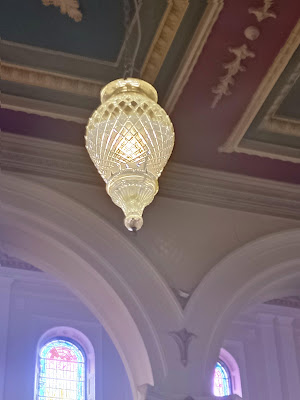Recently, I formed the ambition of visiting all the churches in Dublin. Of course, I've been to a fair few of them already. Whether it's realistic to visit them all, I'm not sure, but I'm going to try. In a leisurely fashion, of course.
I'm interested in churches for many reasons, but one reason is that most churches occupy that ambiguous territory between scenic and mundane. Obviously, cathedrals and otherwise magnificent churches firmly fall within the "scenic" category, and are duly included in guidebooks and the like.
But most churches are neither one nor the other. They are, as Samuel Johnson said about the Giant's Causeway, worth seeing but not worth going to see. (In Philip Larkin's famous poem "Church Going", the narrator reflects that "the place was not worth stopping for".) They are generic, for the most part, but not nearly as generic as a supermarket or a block of flats.
I've always been interested in such "liminal spaces", to use a vogue term. It's the same reason I'm interested in the recent past.
I had a three-day weekend this week so I visited three churches. The first was a church in Milltown, which bears the rather cumbersome title The Church of the Assumption of the Blessed Virgin and Saints Gall and Columbanus. It was built in 1819 and added to in 1935. It was originally built on the site of a stable, and it still has a stable-like aesthetic all these years later (not a bad thing).
This church was pleasant enough, and I was interested to see a bust of St. John XXIII. At the same time, I found something strangely dispiriting about my visit, and I'm not sure why. I attended a vigil Mass there, and the congregation was fairly sparse, mostly elderly. The homily was unobjectionable but I don't remember much of it. (The gospel that Sunday was the parable of the sower.) Everybody seemed to know each other.
The next church I attended, on Sunday morning, was St. Joseph the Artisan church in Bonnybrook, Coolock, which was built in the 1960's. Although I've often been to Coolock (a place I like, especially the Northside Shopping Centre), I'd never even heard of Bonnybrook. (I'm fascinated by these places which are so local, you never hear the name used in general discourse.)






I really, really liked this church. It's almost the classic example of what I appreciate in a church. It's unmistakeably suburban, a long way away from the city centre. It's bright and clean and well-maintained. It's plain, but not excessively plain. And I liked the mild modernism of the altar, with the light shining behind the cross.
The homily was good, too. It compared the cult of productivity to God's patience. When the priest said: "Our worth is measured in productivity by capitalism", I thought: "Ho, hum". When he added: "And socialism", I sat up.
There was a good congregation, with a mixture of ages and ethnicities, and a community atmosphere. A young couple with two infant children were sitting beside me.
On Monday morning, I went to the church of St. Pius X in Terenure, for ten o'clock Mass. This church was built in 1960.

I was really taken aback by this church. It's huge, and remarkably ornate. I found the sheer size a little alienating, but it's undeniably beautiful. The statue of St. Pius X is very appealing, and a helpful reminder of the richness of Catholic history.
Perhaps my favourite detail of this church is the frieze with portraits of saints that runs around the ceiling. There are dozens if not hundreds of individual saints portrayed there, identified by name. I've never seen anything like that and it really gives me an appreciation of the community of saints.
I liked the brown brick exterior of the church. I'm not a fan of every church being made of grey stone. It also reminded me of St. Benedict's in Richmond, Virginia, a beautiful church with reverent services, which I often attended when dating my wife-to-be and which nourished my faith.
From the sublime to the mundane, I also liked that it had a signposted, accessible bathroom. Every church, and every building open to the public, should have this.
The congregation was small and mostly elderly, but that's hardly surprising on a Monday morning. The gospel text was about turning the other cheek, and the priest gave quite a scholarly homily, which was mostly good but a little simplistic when he applied the text to the current situation in Israel.
I also appreciated the recorded choral music which was played during Communion. I know it's a terrible thing to admit, but I prefer recorded music in churches to live music. There's less fuss and ostentation about it; fewer busy-bodies at the microphone before the opening blessing ("Good evening, our opening hymn today.."), no danger of applause, more subdued, and it's not drawn out unreasonably.
I'm not saying I would like to see church choirs abolished. I wouldn't at all. But I do like recorded music in churches. One of my happiest memories is walking into the huge Our Lady of Consolation church in Donnycarney, one day around Christmas, and hearing soft festive music in the background. It was being played on a constant loop.
Anyway, that's the beginning of my trek. Tell me if you find this sort of post interesting.











































